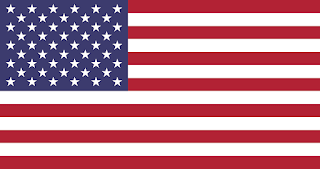All
funerals are an emotional experience filled with some sort of protocol. However, those participating in a military
funeral practice and perform every movement with precision. Every fold
of our flag, every movement, and every gesture is carefully executed. Witnessing all the intricate protocol at the
recent funeral of a relative piqued my interest to study flag etiquette.
When
I want to learn as much as I possibly can, I go to the source for my research.
In this case, I read as many government sources as I could find and discussed
the subject with military
members responsible for performing flag rituals. What follows is what I
learned.
Mourning
When
stated by presidential or gubernatorial order, an official mourning
period is typically reserved for designated government leaders. Although the flag is flown at half-staff, it
is raised to the top of the staff for an instant, lowered to the
halfway position, and then again raised to the top for a moment
before it is lowered. It is quite
dramatic.
Gettysburg
Flag Works states that for "Memorial Day the flag is displayed at half-staff
until noon and at full staff from noon to sunset."
When
covering a coffin, it is placed with the union (the starfield) at the head and
over the left shoulder and never lowered in the grave.
Don't
(s)
As
a greeting gesture we often nod our head to a person on the street. Conversely, this is considered impolite
with a flag; never tip our flag toward a person or thing. There are
specific rules about what we do not do to our nation's symbol.
- Don't fly the flag upside down. This is a distress signal.
- Don't use the flag for decoration or advertising purposes.
- Don't use the flag as decoration on items intended for commercial use.
- Don't use the image as part of a costume. Exceptions: military, police, fire, or patriotic uniform.
- Don't attach a sign, mark, insignia, letter, word, number, figure, etc. to a flagpole, or flag.
- Don't use it to carry anything.
The Treatment of Our Flag
We
treat our flag with tremendous respect and delicately, as if it is special.
Two people raise and lower it quickly with great ceremony while never allowing
it to touch the ground or anything else. When lowering it, one person
gathers the flag as one lowers it. Then both fold and store it
neatly.
As
the flag becomes frayed and beyond appropriateness, it is retired gracefully
and is burned in a "dignified manner". It is most appropriate to find designated
agencies to perform this duty. Until that point, it is to be kept clean and
mended.
Display of Respect Expected from Nonmilitary Civilians
Hand
over our heart for nonmilitary, we salute our flag as it is raised and
lowered. Civilian men should remove
their hats. And if pledging allegiance,
we stand at attention, face the flag with our hand over our heart while
reciting the verses. If the national anthem is played, civilians stand
with the right hand over heart until the song is finished.
Rules for Flying the Flag Outside
Displayed
from a window, balcony, or building:
- The starfield is at the top of the staff unless the flag is at half-staff.
Displayed
with another flag:
- If on the same flagpole, the US flag is at the top.
- No other flag may be larger.
- No other flag may be above it.
If
on a different flagpole, the US flag is on its right.
- The US flag is first up and last down.
Flags
of other countries should be on separate poles and should be the same
size. All the flags should be raised and lowered at the same time and
should be the same height.
Fly
the flag vertically when displayed over a street (starfield positioned north
or east).
The
canton is farthest from the building when it is flown over a sidewalk.
Do
not fly after sunset unless it is illuminated.
Indoors?
Place
the US flag on the right, always in the place of honor. Say there is a
speaker at a function, the flag would be placed on the speaker's right. All
other flags are placed to the left. When there are a group of flags, the US
flag is placed in the center, higher than the others. Yet, when our
flag's staff is crossed with the flag of another, the US flag's
staff is in front with the flag on its own right.
There
are times that we would want to display the US flag against a wall. It
doesn't matter if it is displayed vertically or horizontally, the starfield
would be at the top, to its own right, and to the observer’s left.
More
by The Polite One
Coffee House Etiquette or Want a @#&% With That Latte?
Beware Sharing
Too Much & Hurting Others on Social Networking Sites
Use Your Best Manners When Visiting the Zoo
Photo credit: File:Flag of the United States.svg - Wikipedia public domain

Comments
Post a Comment